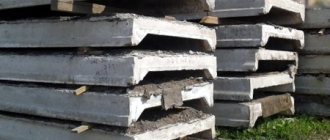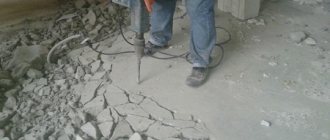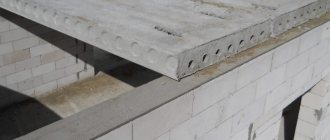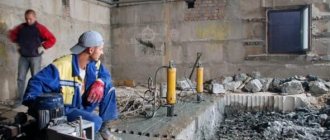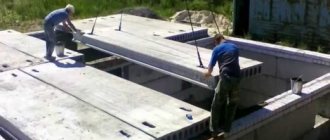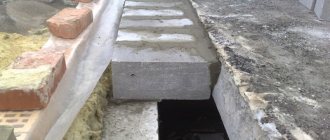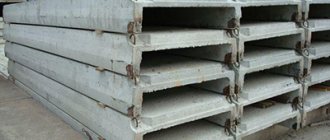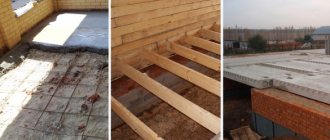One of the difficult, but often necessary, work is the dismantling of floor slabs.
Such work should be performed only by professionals. To carry out the work competently, you must first of all choose the right technology and method for dismantling the floors.
In addition to special knowledge and skills, such work requires the use of equipment, special devices and devices, as well as careful preparation so as not to destroy the walls of the building.
When might it be required?
The need to carry out work on dismantling and removing floors appears for various reasons:
Changing the layout of the room.- Installation of staircase openings when combining two floors.
- When there is a need to increase the load-bearing capacity of walls, foundations or columns.
- When installing large equipment.
- When installing communication structures.
- During the phased dismantling of a building, which includes, in addition to the removal of floors, the removal of walls, partitions and other elements.
- Elimination of certain structures in which defects have been identified that affect the stability of the entire structure.
When not to do it?
If, under the influence of natural or temporary factors, concrete structures begin to collapse and the building has lost its strength and stability, then the floors cannot be dismantled. In this case, the building is completely demolished.
Stages of dismantling work
The technical map for the dismantling of floors clearly regulates the scheme of work, each stage of which must be strictly observed :
- establishing the type of materials used to make the partition. The choice of dismantling technology directly depends on the structure of the structure;
- checking each structural element for its integrity and presence of defects;
- assessment of the reliability of the load-bearing structures of the structure;
- choosing a safe place to install temporary flooring on which the specialists involved in the work process will move;
- preparing a site for building materials and construction waste generated during dismantling of floors;
- strengthening weakened areas of the work site;
- carrying out work to protect the building from destruction during the dismantling of floors;
- removal of electrical wiring, jumpers, plumbing and other communication networks to eliminate the risks of accidents and injuries;
- sealing unnecessary openings;
- dismantling works.
Compliance with this scheme allows you to dismantle the floors with maximum safety and efficiency. Also, attention should be paid to the fact that only with permitting documentation can the work process begin.
When should you turn to specialists, and when can you do it yourself?
Dismantling floor slabs is considered a complex, dangerous and time-consuming job. Due to the variety of types of structures, overall dimensions and their heavy weight, as well as the need to use heavy equipment and special tools, this process is very complex. Only dismantling wooden floors can be done independently , as it is the safest.
The weight of concrete floors can reach several tons, and if the work is not performed correctly, walls and foundations can be damaged.
This can lead to the destruction of the structure, additional costs and even loss of life. Therefore, such complex work should be performed only with the assistance of specialists.
Before deciding to carry out dismantling work yourself, you should carefully and seriously study the process. Manual work will require a lot of effort and time, which will increase labor costs.
Thanks to the floors, the rigidity of the structure is guaranteed, which changes during dismantling, therefore, in order to avoid the building becoming emergency status, all work should be carried out competently . Due to inexperience, communications may also be affected.
Rules for dismantling industrial frame buildings (single-story and multi-story)
The structural system of industrial buildings of industrial facilities is usually framed from steel or reinforced concrete elements.
According to the structural design, frames can be framed or braced.
In frame frames, stability and geometric immutability in the transverse direction is ensured by frames, in the longitudinal direction - by installing steel connections between columns in one step along each row of columns. The connections are usually established in the middle of the temperature block.
Combining two transverse frames into one block using a floor disk and column ties creates a rigid bonded block that provides spatial rigidity and stability.
In braced frames, the stability and geometric immutability of buildings is ensured by the floor disk (covering) and the installation of stiffening diaphragms between columns in both directions or stiffening cores.
The walls of staircases can also serve as diaphragms or stiffening cores.
The demolition or dismantling of buildings must be carried out in such a way that a spatially stable section always remains during the dismantling process. Therefore, dismantling of building structures should begin in the direction from the ends of the building and the expansion joint to the bonding blocks or stiffening cores on both sides. If necessary, provision is made for the installation of temporary elements that provide the necessary stability. The structures of the connection blocks are disassembled last.
Dismantling of structures of multi-storey buildings is carried out layer by layer, (floor by floor), element by element. Work on the next tier is permitted only after complete completion of work on the previous tier.
What tools, equipment and protective equipment will be required?
Before starting work, the master must draw up a work plan and a list of necessary tools, equipment and machinery. With the wrong approach and choice of equipment, irreparable harm can be caused to the facility and people’s lives.
Depending on the types of floors, the following tools and devices may be needed:
jackhammer;- sledgehammer;
- scrap;
- perforator;
- gas or electric cutter;
- Bulgarian;
- jack;
- supports of various types;
- wooden beams;
- device for diamond cutting;
- crushing bucket;
- hydraulic cushions.
To remove debris from the site, you will need a lift, winches and a truck.
Types of floors
Depending on the manufacturing features, installation method, materials used and other factors, there are different types of floors.
Based on their location, floors are divided into:
- basement;
- basement;
- interfloor;
- attics.
According to the design features of the ceiling, they can be:
- beam, consisting of beams and roll-up (beamless filling);
- beamless, made of panels or slabs with a homogeneous composition.
Based on the materials used, all floors are divided into two main groups: wood and reinforced concrete. Wooden ones are simple to construct, do not place a large load on the walls due to their low weight, but they also have disadvantages - increased flammability, susceptibility to pests and rotting.
Reinforced concrete has increased reliability, strength and durability and is divided into:
- prefabricated structures consisting of ready-made reinforced concrete slabs;
- monolithic, cast into removable horizontal formwork;
- ribbed, made with a solid slab in the upper part and ribs in one or two directions;
- made of polystyrene concrete, which is often called lightweight concrete. Due to their light weight, the structures do not place high loads on the foundation and supporting frame, while such floors have excellent heat, sound insulation and strength properties.
Often, combined solutions are used during construction, for example, some of the floors are made monolithic, and some are made prefabricated. It is also possible to combine different materials, if provided for in the design documentation. The combinations can be different, for example, use reinforced concrete to create interfloor ceilings, and use wood to cover a poorly used attic.
What types and methods exist?
Concrete floors are destroyed using impact and non-impact methods. In the impact method, a jackhammer is used . This method has a number of advantages and disadvantages. On the one hand, this is the cheapest, most economical and safe option, but on the other hand, it is noisy and dusty.
With unstressed cutting, they use different types of cutting. This option is silent, so it can be used in apartment buildings.
Diamond cutting
Diamond cutting can be used to remove hard concrete slabs. This could be a drill or a diamond-coated disk.
This method has the following advantages:
- accuracy of work;
- low vibration;
- minimum dust and noise.
Diamond wire cutting
This technology is harmless and virtually silent. This method is used when disassembling slabs of a certain thickness. To quickly and efficiently complete the work, you will need several people.
Thermal method
The plates are heated with high-power plasma or gas devices, as a result of which cracks appear in them and they are carefully disassembled.
Ultrasound
When slabs are exposed to ultrasound, the material begins to compress and stretch, resulting in erosion . Before starting work, a hole is made in the slab through which the sound wave is directed.
For this method, you will need special equipment that will create microvibrations inside the slab.
Using special mixtures
There are cases when chemical mixtures (НРС-1М and НРВ-80) are used to dismantle floors. These compounds are placed in slabs, which crack and after 2 days all that remains is to remove the debris.
Dismantling of roofs of panel and frame buildings
Dismantling the roof is carried out in the following sequence:
- dismantling the roof covering;
- dismantling of parapet panels, cornice blocks and covering slabs.
It is recommended to divide the roofing covering (soft, rolled, mastic, metal sheets) into strips of 1000x500 mm (slabs of 1000x1000 mm) that are convenient for carrying and storing.
The cemented joints, seams, and metal connections of roofing slabs (flooring) are freed from the mortar. It is recommended to sling roofing slabs using a four-legged sling and four grips, which are installed in specially drilled (punched) holes. Then the crane slightly tightens the slings and cuts the metal connections.
The roofing slab is torn off using a hydraulic wedge or jacks and lifted a few centimeters with a crane. Before lifting, the roofing slab is raised 20-30 cm to check the reliability of the sling. In the same way, parapet panels, cornice blocks and house covering slabs are dismantled.
Step-by-step instructions on how to dismantle
Dismantling the floor slabs of an existing building is considered a rather difficult task. When dismantling various types of structures, you have to follow certain rules and regulations .
In order to choose the most effective and safe method of dismantling, before starting work, the structure is inspected, assessing the degree of wear of the slabs. Communications are removed even before dismantling work begins. They dismantle the floor coverings and prepare a place for the falling fragments of slabs.
Wooden structures
Stages of work:
- The backfill, boards, and running boards are removed.
- The roll-ups are being sorted out.
- With the help of the house, the beam and ceiling lining is dismantled.
- The beams are removed.
- Supports are installed on the sides.
If the beams are intended to be reused, then the work is carried out in the following order:
- temporary supports are secured under the beams;
- the edges of the beams are released, widening the gap and bending the metal fasteners;
- the beam is brought out onto the installed scaffolding and one of its edges is sawed off;
- parts of the beam are lowered to the lower floor and carried out through the window openings.
Concrete
Stages of work:
- The cement screed is destroyed and removed.
- Grooves 30 cm wide are cut.
- Using a jackhammer, fragments of cement are broken off.
- Find out the location of the reinforcement inside the slab and its direction.
- Using a jackhammer, destroy the slab as the reinforcement is laid in strips 40 cm wide.
- Reinforcing bars are cut using a cutter.
Next, the load-bearing beams are disassembled:
- secure the supports;
- break slabs;
- cut the reinforcement frame.
Concrete and brick
Stages of work:
- The backfill is removed.
- The base is disassembled.
- Beams are removed.
Such floors are dismantled using the transverse or longitudinal method. Spacers are installed at a distance of 1.5-2 m. The vault is destroyed in parts 2 m long. With the longitudinal method, spacers from beams 18 cm thick are installed from below the beams at a distance of 3 m from each other. They will take on the load of the adjacent vaults.
Void
Dismantling of hollow core slabs is carried out entirely, using a truck crane or other lifting equipment . If the use of lifting machines is not possible, then dismantling is carried out manually, which involves the mandatory installation of formwork or frame scaffolding under the slabs. The slabs are cut into lifting pieces with a jackhammer or circular saw.
Monolithic
Using a jackhammer or concrete breaker with this method is considered the most economical dismantling of a monolithic floor.
The reinforcement is cut with a cutter or grinder . But with this method there is a risk of destruction of the object due to high vibration due to the operation of fendering equipment.
Vibration load can be minimized by using diamond cutting. In this case, not only will communications be preserved, but there will be less dust and the time required to complete the work will be reduced.
Often the dismantling of monolithic floors will be carried out in a mixed way, using different tools. A diamond tool is used to cut along the perimeter by 2/3 of the thickness of the ceiling. The internal parts are destroyed using a jackhammer or concrete breaker.
Features of dismantling various types of floors
Figure 1. Dismantling floor slabs
for proper dismantling of floor slabs . First, all plumbing communications, electrical wires, and water pipes are removed. The floor covering is also removed. The lower levels, as well as the area around the entire building, are fenced off, because parts of the concrete structures may fall.
If it is necessary to dismantle the ceiling on several floors, then this should not be done at the same time. To disassemble the structure you will need a crane or winch. As for the order of work, first remove the cement screed and divide the slab into parts 30 cm wide using grooves. Next, the pieces of the structure are separated with a jackhammer.
Since there is a frame made of reinforcement inside the slabs, a gas cutter is used to dismantle it. Lastly, the supporting beams are removed. To disassemble a concrete vault, a longitudinal or transverse method is used. When destroying monolithic floors, the same principle is used as with slabs. To carry out the work yourself, you will need: a sledgehammer and a hammer, a hammer drill, a grinder, a nail puller, a crowbar, a hydraulic jack, supports, a gas cutter.
Possible difficulties and errors during the disassembly process
Before you begin dismantling the floor slabs, you should make sure that the material does not collapse on the lower floors . To do this, the dismantled parts must be supported using a crane or winch.
If there is a threat of slab crumbling, the part to be removed should be strengthened with anchors, nets, staples, or a protective coating should be laid on the lower objects. Fragments of a large area are divided into parts and removed through window openings.
It must be remembered that all work must be carried out according to the project , so as not to disturb the solidity of the supporting structures, thereby avoiding the collapse of the structure. Before starting work on dismantling the floors, you should take care of cargo transport for removing garbage and waste.
During dismantling, workers must wear special clothing, safety helmets, goggles and gloves. And when working with a noisy instrument, use special headphones.
6. OCCUPATIONAL SAFETY
6.1. When dismantling floors over wooden beams during the reconstruction of buildings and structures during the work process, workers may be exposed to the following hazardous and harmful production factors associated with the nature of the work:
— spontaneous collapse of structural elements of a building and falling construction debris;
— moving parts of the hand tools used;
— increased content of dust and harmful substances in the air of the working area;
— location of the workplace near a difference at a height of 1.3 m or more;
— sharp edges, corners, protruding pins;
— moving parts of a load-lifting crane;
— moving materials and structures from disassembly.
6.2. Before the start of repair work, the preparatory work provided for by the project must be completed, the completion of which must be accepted according to the act on the implementation of occupational safety measures.
6.3. Persons at least 18 years of age who have professional skills, have undergone a medical examination and are found fit, and have acquired knowledge of safe labor methods and techniques in accordance with the “SSBT. Organization of occupational safety training. General provisions”, who passed the qualification commission exams in the prescribed manner and received the appropriate certificates.
6.4. Simultaneous work on dismantling structures or dismantling equipment during the dismantling of floors in several tiers of one vertical grip is not allowed. Access to the underlying floors and adjacent areas must be closed.
6.5. Floors must not have unprotected openings. Openings in walls with window sills below 70 cm, doorways to the area where the ceilings are dismantled must be securely closed, openings in the ceilings must be fenced to a height of 1.1 m.
6.6. It is prohibited to overload the floors with construction waste and materials from dismantling. Accumulated construction waste and materials from dismantling must be removed immediately.
6.7. When dismantling ceilings, it is forbidden to work on pick-ups (rolling), as well as to store materials from dismantling and construction waste on them.
6.8. It is prohibited to stand on the ceiling lining after removing the supports.
6.9. It is prohibited to carry wooden beams and other loads by crane over the workplace where dismantling is being carried out and over adjacent grips.
6.10. In adjacent sections of the building, dismantling all floors at the same time is prohibited. During the process of dismantling old floors and installing new floors, the internal main walls of a building must maintain a structural connection with the floors located in adjacent sections.
6.11. Window openings with disassembled fillings must be covered with two or three boards, doorways in the walls enclosing areas with disassembled floors must be securely blocked.
6.12. When dismantling wooden floor beams in multi-story buildings, it is necessary to preserve every fourth beam embedded in the wall to ensure spatial rigidity and stability of the building when the floors are completely dismantled. The beams left on the floor should be located in the same vertical and dismantled as new floor elements are installed and anchored.
6.13. During repair work, areas that are dangerous for people must be fenced off and have warning signs about the danger. To prevent access by unauthorized persons, production areas and work areas must be surrounded by a protective fence with a height of at least 1.6 m and at least 1.2 m, respectively. Fences adjacent to places of mass passage of people must have a height of at least 2 m and be equipped with a continuous protective visor.
6.14. Workplaces and passages to them, located on floors, coverings at a height of more than 1.3 m and at a distance of less than 2 m from the height difference, must be fenced with safety or safety fences, and at a distance of more than 2 m - with signal fences, appropriate requirements of GOST 12.4.059-89.
6.15. Openings in walls with window sills below 70 cm, doorways to the area where the ceilings are dismantled must be securely closed, openings in the ceilings must be fenced to a height of 1.1 m.
6.16. Entrances to buildings and structures being reconstructed must be protected from above by a canopy at least 2 m wide from the building wall. The angle formed between the canopy and the wall above the entrance should be 70-75°.
6.17. Construction sites, work areas and workplaces, passages and approaches to them in the dark must be illuminated in accordance with the requirements of GOST 12.1.046-85. Lighting of enclosed spaces must comply with the requirements of SNiP 23-05-95*.
Illumination should be uniform, without the glare of lighting devices on workers. Work in unlit areas is not allowed.
6.18. To ensure safe working conditions in accordance with Article 9.4.2 of PB 10-382-00, responsible engineering and technical workers and slingers must be appointed.
Production areas, work areas and workplaces must be provided with the necessary means of collective and individual protection of workers, primary fire extinguishing means, as well as communications, alarms and other technical means of ensuring safe working conditions, in accordance with the requirements of current regulatory documents and the terms of agreements.
6.19. During disassembly work, radio communication between assemblers and riggers and the crane operator must be ensured.
6.20. The “Stop” signal is given by any employee who notices the danger.
6.21. When dismantling floor beams, tie hemp ropes (guys) to them, with which installers keep the element from swinging and hitting the building structure. The lifting of the dismantled element must be smooth without jerks or jolts. Installers must be located on the side opposite to the movement of the beam and must be outside the boundaries of the danger zone.
6.22. It is prohibited to leave overhanging, unstable structures or individual elements of the building that can spontaneously collapse (boards, panel boards, insulation, etc.).
6.23. Particular care should be taken when dismantling floors affected by house fungus or beetles. If an emergency condition of structures is detected, workers must be immediately removed from the danger zone. The dangerous zone, in accordance with the requirements of SNiP 12-03-2001, must be immediately fenced off with the installation of warning signs or a guard posted. Work can begin upon the written instructions of the chief engineer and the execution of a work permit indicating measures that guarantee safe working conditions.
6.24. Workers must be provided with safety belts with a safety cord, the carabiner of which is securely attached to a solid structure specified by the foreman or foreman.
6.25. Persons at least 18 years of age who have passed a medical examination, trained in the rules of using the tool and labor safety, and have an electrical safety group of at least II are allowed to work with electrified tools, and for connecting and disconnecting electrical points with a group of at least III. All electrified tools are subject to accounting and registration in a special journal. Each instrument must have an accounting number. Monitoring the serviceability and timely repair of electrified tools is assigned to the department of the chief mechanic of the construction organization. Before issuing an electrified tool, it is necessary to check its serviceability (no short circuit to the body, insulation of the supply wires and handles, condition of the working part of the tool) and its operation at idle speed.
6.26. When cutting structural elements, measures must be taken to prevent accidental collapse of the cut elements.
6.27. All workers must be provided with special clothing, shoes and other personal protective equipment.
6.28. To prevent dust formation and extinguish rising dust when dismantling floors, construction waste must be moistened with water. A dense synthetic mesh should be stretched along the facades of the building.
6.29. Load-handling devices and containers used when moving loads by cranes must be tested with a load that is at least 2 times greater than their rated load capacity.
6.30. In the work area it is necessary to have sets of fire-fighting equipment at the rate of 1 set per 200 m2 of area.
6.31 All work on dismantling and dismantling of floor structures should be carried out in the presence and under the guidance of responsible engineers in accordance with the rules for the production and acceptance of work in accordance with SNiP 3.03.01-87, while observing labor safety requirements in accordance with: SNiP 12-01-2004 “Construction Organization”; SNiP 12-03-2001 “Labor safety in construction. Part 1. General provisions"; SNiP 12-04-2002 “Labor safety in construction. Part 2. Construction production"; PPB 01-03 “Fire Safety Rules in the Russian Federation”; SanPiN 2.2.3.1384-03 “Hygienic requirements for the organization of construction production and construction work”; SP 12-135-2003 “Labor safety in construction. Industry standard instructions on labor protection."
How is the estimate prepared and what indicators are taken into account?
One of the most difficult types of work is the dismantling of floor slabs of a working building. When dismantling, builders have to work with different types of structures, and they all require compliance with certain rules and regulations.
Before drawing up an estimate, specialists examine the structure and especially the floor slabs, assess the degree of wear, and choose a safe and effective method of dismantling work. All this information and the plan for dismantling work are entered into the technological map and an estimate is drawn up.
Dismantling of residential and public buildings with brick walls
Sequence of work:
- dismantling the roof;
- dismantling the roof fence;
- dismantling wooden structures of pitched roofs;
- dismantling the attic floor;
- floor-by-floor dismantling of external and internal walls;
- floor-by-floor dismantling of interfloor ceilings;
- floor demolition;
- floor-by-floor dismantling of staircases and landings;
- dismantling the ceiling above the basement;
- dismantling basement walls and foundations.
Average cost of work in the Russian Federation
The cost of dismantling the floors is estimated per 1 sq. m. The final price of dismantling work depends on the following factors:
concrete slab thickness;- concrete class;
- presence of defects;
- ceiling placement heights;
- the chosen method of dismantling work;
- the presence of reinforcement, its size and method of reinforcement;
- associated factors.
Approximate prices for dismantling work of various types of floors per 1 sq. m.:
| Type of floors | Cost of work (rub.) |
| Reinforced concrete floors | from 850 |
| Floor slabs | from 350 |
| Concrete floors | from 700 |
| Wooden floors | from 250 |
| Dismantling floor beams | from 1500 |
Separately for each project, calculations are made for possible related work:
- energy supply;
- delivery of equipment and its removal;
- cutting iron reinforcement;
- technical inspection of the floor condition;
- anti-dust measures;
- lifting actions;
- installation and dismantling of re-supporting racks;
- loading and removal of construction waste;
- PPR plan or development of a dismantling project.
Determining the cost and complexity of work when dismantling slabs
If you don’t plan to dismantle it yourself, it’s worth calculating the approximate cost of completing the task. Usually the price is quite high, since this is a complex job: dismantling floor slabs requires the involvement of tools, equipment, and professionals; the process can pose a risk to health and life.
In order to accurately calculate the cost of work, the contractor must provide information about the design features and all accurate descriptions of the object. The price will depend on the size of the object, the volume of work, the height of the building, the ability to fit special equipment, etc. Much depends on the destruction method used.
Methods for dismantling ceilings:
- Dynamic destruction
– impact hydraulic hammer: cheap, fast.
- Wire or diamond cutting
– if dynamic loads cannot be applied.
- Hydraulic fracturing or rapidly expanding concrete
– relevant inside working shopping centers, workshops, enterprises, since the dismantling method does not involve the appearance of noise and dust.
- Use of robotic technology.
- Combination of several methods.
The decision to use certain methods is made by the contractor and provides the customer with a work plan and justification for the methods used. The final price is calculated for each square meter.
Parameters for pricing:
- Concrete class, defects
- Concrete thickness
- Availability of reinforcing bars, their cross-section, reinforcement method
- Floor slab height
- Dismantling method used
- External factors influencing the complexity of work
How to properly dismantle concrete?
Dismantling concrete is one of the most difficult and underestimated processes from the point of view of construction technology. Disassembling the supporting structures of a house can be useful in various situations, ranging from minor alterations inside the building to its complete destruction.
Dismantling concrete with a hammer drill
But how is the dismantling of reinforced concrete structures carried out? What devices are used for such tasks, and what is the work process? Now you'll find out.
Features and varieties
First, let's look at the features of this process and why dismantling is needed at all.
There are two main categories of demolition of concrete structures:
- Complete dismantling;
- Partial dismantling.
In the first case, we are dealing with complete destruction of the structure. Such actions are necessary when the house has already outlived its usefulness and is subject to demolition. Situations are not excluded when the design simply does not cope with its tasks.
If we take the dismantling of floors as a basic example, they can be removed in cases where the supporting structure of the floors cannot withstand the allocated loads or is too damaged.
The second type of such work is partial dismantling. This includes partial disassembly of the structure, if possible, while maintaining its load-bearing capabilities. For floors, partial disassembly means that, for example, it is planned to make an additional hole in them for a staircase or floor in the form of a through gallery.
In such cases, completely dismantling the house is inconvenient and even harmful.
We examined two main directions in which the dismantling of reinforced concrete structures is carried out, because they differ greatly from each other in the scheme of actions, the equipment used and the level of force applied.
Next, let's turn our attention to the process itself, as well as the tools used in it.
Equipment used
If the task is the complete destruction of the structure or the entire building, then large-scale means are used.
Manual dismantling of concrete structures
The simplest and most effective option is explosives. For the most part, buildings that are subject to demolition, consisting of at least several floors, are simply blown up.
Such actions are completely justified, because a correctly placed charge allows for the dismantling of concrete structures almost instantly. The building begins to take shape like a house of cards.
Thousands of man- and machine-hours, and believe me, the hours allocated for the dismantling of such large buildings are counted in thousands, are saved thanks to a properly installed system of explosives.
On the other hand, explosives are not a cheap pleasure. And this concerns not only money. Only high-class demolition specialists, whose services are very expensive, are allowed to work with it. It is equally difficult to obtain permits for blasting, especially if blasting operations are planned to be carried out in a densely populated area.
Equipment for partial dismantling
Partial concrete dismantling offers us a much richer arsenal of equipment. Here they use:
- Hand tools;
- Equipment on excavators;
- Hydraulic wedges;
- Chemical mixtures.
Let's look at each type of tool in more detail.
Hand-held equipment includes tools that are, so to speak, “small caliber.” These are all kinds of hammer drills, manual jackhammers, grinders, etc.
A person operates a hand tool, as you probably guessed. Their advantages are the highest precision of work. Using a hammer drill correctly, you can drill a neat hole of the required size in the monolith, which will not affect any communications.
Cons: low performance. Concrete is a durable material, and it only gets stronger over time. Unlike bricks or blocks, it can take a long time to disassemble. Dismantling concrete structures manually is hellish work, and if it involves dismantling reinforced concrete, then things take an even more stressful turn.
Using a manual grinder
However, a team of workers with good tools will carry out local tasks, for example, dismantling a concrete wall, without any costs.
Excavator equipment involves the use of hydraulic hammers, chippers, etc. An excavator in capable hands works extremely accurately and efficiently. It is used when quick and high-quality dismantling of reinforced concrete, walls, ceilings, etc. is needed.
A hydraulic wedge is a special type of equipment that is used to destroy load-bearing structures such as floors, walls, foundations, etc.
The principle of operation of the wedge is extremely simple. A round hole with a diameter of 10 to 20 cm is cut out in the structure planned for demolition. A wedge is inserted into it. A hydraulic pump is connected to the wedge.
The pump pumps liquid into the wedge piston, which begins to increase in size, thus affecting the supporting structure. Several correctly installed wedges can destroy walls of any thickness.
The last option is expandable type chemical mixtures. The ideal direction for their use is filling existing cracks. The mixtures are chemically active and initiate a chemical reaction upon contact. In a day or two (the period depends on the quality of the mixture, the durability of the concrete, atmospheric conditions, etc.) the concrete will become much softer.
It is permissible to use such solutions only in the case of partial dismantling, mainly of non-load-bearing or self-supporting structures.
Working with a hydraulic wedge (video)
Scheme of work
Let us consider the very scheme of actions when dismantling concrete structures.
Contrary to popular belief, the destruction or dismantling of concrete, even partial, does not come down to a banal hammering on the wall. Here you need to act in a complex manner.
Stages of work:
- Preparation for dismantling, disconnecting communications, fencing the work area, installing supports (for load-bearing floors or walls).
- Preparation of tools, planning of the scheme and principles of dismantling.
- Direct dismantling.
- Crushing and removal of construction waste.
The circuit itself should work like a clock. Particular attention should be paid to garbage disposal. Such a seemingly insignificant thing still has a significant impact on the speed and efficiency of the workflow.
When dismantling a wall or ceiling, construction waste quickly fills the entire space, so in addition to the removal itself, you also need to consider a scheme for crushing it and loading it onto trucks.
Dismantling walls and ceilings
Dismantling concrete walls and floors is one of the most common work tasks.
Dismantling walls with a hydraulic wedge
Such structures can only be disassembled after first removing and disconnecting all communications. This primarily concerns electricity, gas pipes and plumbing.
If the structure is load-bearing, then dismantling is permissible only after installing safety struts. This is especially true when working with floors, since they hold the weight of all the higher walls above them.
Only fully equipped professionals are allowed to destroy load-bearing structures.
When it comes to equipment, builders prefer hydraulic wedges for demolishing walls and excavators for working on floors. Partial disassembly involves the use of hand tools (grinders and large hammer drills); any other approach threatens excessive damage, which we would like to avoid with partial dismantling.
Dismantling the screed
Dismantling a concrete floor, as well as dismantling screeds, is an even more popular task in amateur construction. Unlike demolition of load-bearing structures, the screed and floor can be disassembled as you wish.
Dismantling the screed with a hammer drill
The most reasonable and economical method in terms of resources spent is the use of manual hammer drills or chemical mixtures.
Both the first and second options are almost perfect. If the screed is heavily reinforced, which is rare, then it would be wiser to first saw it into separate sections using a grinder and diamond blades, and then remove each section with a hammer drill.
It is obvious that even when carrying out such minor work, it is imperative to take care of personal safety. This primarily applies to gloves and safety glasses. Let us pay special attention to the presence of glasses.
Hand hammers can scrape out individual pebbles from concrete that fly in all directions. Without glasses, there is a high risk of eye damage while working. It is also advisable to have protective overalls, a hat and a respirator.
popenobloky.ru
Various methods for dismantling concrete
Comments:
Rating: 19
Dismantling of concrete is currently carried out using a hydrocline. This is a special concrete breaker that is successfully used by many construction companies. Traditional methods of concrete dismantling have a number of significant disadvantages: increased noise levels, high costs for various equipment, the work takes a long time due to its labor intensity. There is a high chance of injury.
Traditional concrete dismantling has a number of significant disadvantages: high noise levels, high equipment costs, labor intensity and risk of injury.
Construction activities, especially within the city, are carried out in different directions; very often it is necessary to clear the area for the construction of another facility. In this case, removal of old concrete buildings is required. So, dismantling work begins.
If you start dismantling concrete structures on your own, it will take too much time, cost and effort. The cost of demolition can reach up to 10% of the total construction budget, and labor intensity, including waste removal, can account for 1/3 of the total labor costs. Therefore, it is more advisable to use the services of specialized construction companies.
Dismantling of concrete walls, reinforced concrete and structures
For greater benefits, it is recommended to use the services of professional construction companies.
The dismantling of concrete walls and concrete structures using expanding wedges has been known since ancient times, when construction was carried out using stone blocks. Then it was necessary to crush stones using wooden wedges that were driven into special holes. Subsequently, of course, this method was improved. Currently, a type of dismantling of concrete walls called driving in a hydrocline has become widespread. This allows you to cope with reinforced concrete, large-area concrete structures, and brick walls. Natural stone, in particular granite and marble, can also be suitable for these purposes. Outside our state, in Western countries, the dismantling of concrete walls with a hydrocline has been used for 30 years. The use of hydrocline can be in any field of construction and in any territory. To carry out large-scale work on dismantling reinforced concrete and other structures, it is advisable to use a hydrocline.
The use of hydrocline can be carried out in the following directions:
- When dismantling concrete of various sizes and widths, as well as length.
- Destruction of massifs of concrete structures.
- Reinforced concrete pads can be dismantled.
- Crushing of natural building stone (granite, marble, rubble).
- Dismantling concrete using a hydraulic wedge on brick walls.
- Hydraulic structures are being dismantled using a hydraulic wedge.
Return to contents
The use of a hydrocline can be carried out when dismantling concrete of different widths and sizes.
In order to proceed directly to the dismantling of concrete, a preparatory stage is carried out. This is voluminous and sometimes lengthy work, which includes the following activities:
- A preliminary inspection of the site where dismantling work will take place is carried out.
- The conditions for the work are being agreed upon.
- Utility networks, if any, are disconnected.
- Preparation of access roads, as empty space for equipment will be required.
- Next, engineering equipment is installed and prepared.
Disassembly work begins, which usually includes two stages:
Concrete walls can be dismantled using diamond cutting.
- Carrying out dismantling of concrete structures. This is the removal of various structures, the division of these structures into smaller parts. If monolithic parts of buildings are unsuitable for recycling, they are destroyed and crushed using a hydrocline.
- Next, work begins to remove debris from the area. The dismantled material is sorted, loaded onto harvesting vehicles and removed from the area.
Such work must be carried out according to a clearly defined plan. An important point in dismantling concrete is that it is necessary to ensure the stability of structures at the time of their dismantling, to try to prevent their premature and arbitrary destruction, since this is very dangerous and can cost the lives of many workers. Therefore, only professionals in their field should be involved in such work, since in this case we are talking not only about the work being done correctly, but also about the safety and health of all workers.
Return to contents
Hydrocline is popularly called a concrete breaker. The latest technologies make it possible in our time to dismantle concrete without causing any problems to others. Modern dismantling work is carried out without noise and vibration, which earlier methods of concrete dismantling could not afford. This method is very good if dismantling of concrete structures is carried out near residential areas. Another advantage of using a hydraulic wedge in dismantling work is the control of the entire work process. For example, it is necessary to break a specific section without damaging the integrity of the entire structure; a hydrocline can easily cope with this.
Dismantling walls using a hammer drill is possible, but it will take a very long time.
In this way, it is possible to avoid problems such as fragments and sharp parts that fly off over distances, which is completely unsafe for this type of work. This method is good if dismantling work is carried out over a rather large area, where other workers may be located at a short distance. At this time, jackhammers and rotary hammers, of course, are still used, but they are already considered outdated methods and not entirely safe. For example, in the West, the method of dismantling concrete using a hydrocline has been used for 30 years.
Another advantage of using a hydrocline is that it is economical to use. Firstly, it costs less on electricity, and secondly, it is compact for transportation. This cannot be said about old air compressors, for example. A more advanced method of concrete dismantling—diamond wire cutting—is becoming widespread.
Return to contents
Concrete floors are the basis of concrete structures; they are characterized by high strength and resistance to various forces. Therefore, the dismantling of concrete floors must be approached with all responsibility; it should be remembered that this work can be not only labor-intensive, but also dangerous.
If you approach your work in an amateurish way, you won't be able to avoid problems. The entire integrity of the building depends on proper operation, since the floors serve as supports for concrete walls. This work should be carried out by trained personnel using good, up-to-date equipment. The construction site must have crane equipment, hydraulic cushions, a jack, diamond cutting power tools, various pneumatic devices, etc. There must be special vehicles for garbage removal.
The primary basis should be familiarization and thorough inspection of the floors, drawing up a work plan. Dismantling of concrete floors can be complete or partial, when, for example, it is necessary to dismantle the floor to install a staircase.
Partial dismantling is more complicated than complete dismantling, as it requires careful calculation of the destruction of the object.
First, the floor or floor coverings are removed, then the screeds are dismantled and the underground embankments are removed, supports are installed, if necessary, the slab is removed or partially dismantled.
When dismantling concrete floors, it is not advisable to use a jackhammer, as this may damage the integrity of other structures that do not require dismantling. When dismantling a certain area, you will need to use jack stands. Previously, when drawing up a work plan, workers must calculate how many jack stands may be needed when dismantling the floors. All these activities must be carried out legally, with all permits available.
Return to contents
Another type of dismantling work is dismantling the floor screed. This process requires special skills and patience. A floor screed will be needed if cracks and unevenness appear on the concrete floor, there is a need to lower the floor covering, communications run under the floor and they require repair, etc. Dismantling of a concrete floor screed can be done manually or “by machine.”
Necessary tools and equipment:
- jackhammer or hammer drill;
- gloves;
- protective mask.
Concrete dismantling can be complete or partial. The best method for dismantling concrete, as mentioned above, is diamond cutting. It provides noise reduction and is more convenient to use. But when this is not possible, you can use a jackhammer or hammer drill. Any method of dismantling a concrete floor is based on breaking the concrete into small pieces. You need to think in advance about how the garbage will be removed after breaking the floor. If the floor is being dismantled in a residential building, you need to discuss possible inconveniences with your neighbors in advance.
tolkobeton.ru
Dismantling of foundations
Possible foundation designs for dismantling residential and public buildings:
- from rubble stone (ancient buildings);
- concrete monolithic;
- reinforced concrete from prefabricated blocks.
The foundations for the external walls are excavated along the perimeter of the walls using an excavator. The foundations for the internal walls are dug out manually. It is recommended to dismantle foundations using mobile jib cranes.
16. Dismantling of massive reinforced concrete structures
Massive reinforced concrete structures can be foundations for columnar columns of one-story and multi-story industrial buildings, as well as foundations for equipment. Dismantling of such structures must be carried out using one of the collapse methods given in section 7 of SP 325.1325800.2017.
The choice of collapse method is made in the PPR taking into account the following factors:
- the conditions under which collapse work must be carried out;
- Possibility of using lifting, loading and transport equipment;
- availability and possibility of acquiring means for destroying the material of dismantled structures;
- provision of labor force and engineering and technical workers with the required qualifications;
- feasibility study of the selected means of destruction;
- work safety measures.
Dismantling of load-bearing structures of one-story frame buildings
Rafter (sub-rafter) trusses (steel or reinforced concrete), when dismantling the load-bearing and enclosing structures of the covering, are secured using braces or struts to ensure the stability of the system.
Trusses are dismantled in the following sequence:
- the truss is slinged (the slinging location is indicated in the PPR);
- when the sling tension is weak, the bolts and welds on the columns are cut off;
- the trusses are raised 0.5 m above the installation site;
- the farm is transferred to the vehicle.
Transportation of farms is carried out in accordance with the requirements for transportation of new products.
Dismantling of columns of multi-storey industrial buildings (steel and reinforced concrete) is carried out in the following sequence:
- the column, after dismantling the trusses, if required according to the calculation results, is braced for stability by two braces in the plane of least rigidity;
- after slinging the column, the concreting of the base of the columns is broken down and the anchor foundation bolts are cut off (for steel columns), temporary connections are removed;
- a reinforced concrete column, rigidly clamped in the foundation, is cut down, with a weak tension on the slings, the exposed reinforcement of the columns is cut off, and the remaining concrete is knocked out;
- the column rises 0.5 m above the installation site and is transferred to a temporary storage warehouse.
Columns should be stacked with wooden spacers - according to the rules for storing new columns.
Dismantling of crane beams is carried out in the following sequence:
- crane beams are slinged, the slinging locations are indicated in the PPR;
- when the tension of the slings is weak, the steel connecting parts of the beam with the column are cut off, and the anchor bolts are cut off;
- the beam, using a hydraulic wedge or jack, is torn off from the supporting plane and raised above the installation site by 0.5 m;
- the beam is transferred to the vehicle.
Dismantling of steel crane beams 12 m long is carried out in enlarged sections, including crane rails, braking devices and stops;
Dismantling of foundation beams is carried out in the following sequence:
- the blind area is dismantled and soil is excavated to the depth of the foundation using an excavator;
- the embedment concrete between the beams is removed using jackhammers;
- the beam is torn off from the supporting plane using a hydraulic wedge or a jack;
- the beam is raised by 0.5 m and transferred to a temporary storage warehouse or vehicle.
Dismantling of laminated wooden arches and frames
Three-hinged arches and frames with a hinge in the key and with transmission of thrust to the foundations are dismantled using a mobile mounting tower in the ridge area. The tower is equipped with the necessary equipment that allows the structures of half-frames and half-arches to be secured during dismantling. Before dismantling begins, the structure must be unfastened from the plane.
Dismantling is carried out in the following sequence:
- the ridge unit is secured to the tower against vertical movements;
- when slinging one half-frame (half-arch), the ridge assembly and the supporting lower assembly are disassembled (loosened);
- the dismantled half-frame (half-arch) is raised 0.5 m from the design position and transferred to the vehicle;
- The second half of the structure is dismantled.
Dismantling of large-span prefabricated double-hinged arches and frames supported on foundations is carried out in separate parts using mounting supports located in the joint area and equipped with appropriate equipment for dismantling joints and securing parts of structures in a vertical position. Before dismantling begins, the structures are unfastened from the plane. After dismantling the joints and supporting fastenings, parts of the structures are dismantled.
The disassembled structural elements are transferred by crane to vehicles or to a temporary storage area.
When storing, it is necessary to provide protection for wooden structures from prolonged atmospheric influences.
Dismantling of load-bearing wooden structures should be carried out in accordance with the PPR.
Dismantling of buildings (structures) with a frame made of wooden structures
Timber-framed buildings are typically one-story.
Dismantling of wooden frame buildings is carried out according to the rules and in the sequence given for steel and reinforced concrete
designs. Disassembly is carried out in order from top to bottom horizontally from
the end of the building (or expansion joint) in the direction of the bond block.
Dismantling of frame buildings covered with wooden trusses along wooden columns is carried out element by element.
During the process of dismantling structures, trusses and columns freed from adjacent supporting structures must be secured with mounting braces or braces.
Dismantling of wooden trusses is carried out in the following sequence:
- after slinging, with a weak tension on the slings, the supporting units of the trusses are released from the fastenings on the column;
- temporary bracing (struts, guy wires) are dismantled;
- the truss is raised above the column to a height of 0.5 m and transferred to a temporary storage warehouse or vehicle;
- places for slinging trusses with metal lower chords during lifting should ensure the operation of the metal belts in tension.
Wooden columns, when rigidly connected to the foundation, must be untied from the plane before dismantling begins. When the racks are hingedly supported on the foundations, during the period of dismantling, they are decoupled with temporary connections in two planes.
Demolition of emergency buildings and structures and objects after a fire
Buildings and structures with emergency areas, including those caused by fire, should be eliminated by dismantling or collapsing methods. A justified choice of demolition method must be specified in the customer’s assignment, agreed with the regulatory authorities.
When demolishing a facility, all basic rules, sequence and technology for dismantling buildings given in this section must be followed.
Demolition of a building can be carried out using one of the collapsing methods given in section 7 of SP 325.1325800.2017. When working on demolition, especially emergency buildings, it is necessary to comply with safety requirements:
- installation of temporary fastenings;
- fencing the territory;
- installation of scaffolding along the facades of the building, with a stretched mesh as a protective fence.
Source - SP 325.1325800.2017 Buildings and structures. Rules for carrying out work during dismantling and disposal.
Dismantling of structural elements of multi-storey precast concrete frame buildings
Before dismantling the crossbar, the column is braced with struts. Dismantling is carried out in the following sequence:
- the joints of the crossbar with the column are freed from concrete coating,
- the connecting steel parts and welds on the column console are cut off - after slinging the crossbar and loosely tensioning the slings;
- using a hydrocline, the crossbar is separated from the horizontal platform of the column console.
The crossbar is dismantled and transferred to the storage area. After dismantling the crossbar, the column is dismantled, the work is performed in the following sequence:
- columns are slinged;
- if the tension of the slings is weak, the temporary fastenings of the columns (struts) are removed;
- the joint of two columns is freed from embedding concrete;
- steel connecting elements are cut;
- using a hydrocline, the column is raised and moved slightly;
- the upper column is torn off;
- the dismantled column moves to the storage location.


